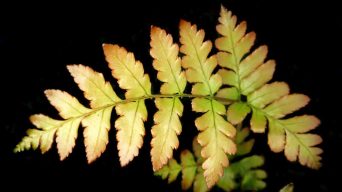Fern plants are grown for their beautiful, lacy leaves, providing a delicate, tropical look to any home.
While ferns are generally low-maintenance plants, they can sometimes experience problems, one of the most common being curling leaves.
However, there are a few different reasons why your fern leaves might be curling, and thankfully, there are also several solutions.
Here are some of the most common reasons for curling fern leaves and what you can do to fix the problem.
Why Are My Fern Leaves Curling and How Can You Fix It?
Ferns are beautiful, delicate plants that can add a touch of elegance to any home.
But what do you do when you notice your fern leaves curling?
There could be several reasons why your fern leaves are curling.
It could be due to your home’s temperature, humidity, or light levels. It could also be a sign that your fern is not getting enough water or nutrients.
Here are some common causes of curling fern leaves and what you can do to fix the problem:
1. Not Enough Water
Fern leaves typically curl when they are dried out from lack of water.
This is because the cells in the leaves are losing water faster than they can replace it.
When the cells lose water, they shrink and become misshapen, causing the leaves to curl.
Ferns are especially sensitive to underwatering, as they have a high surface area to volume ratio.
This means that they lose water more quickly than other plants.
You can tell if your fern is underwatered if the leaves are wilting or the soil is dry.
Also, the edges of the leaves will become dry and brown, and the leaflets will curl inward.
How To Fix It
If you think your fern needs water, the best solution is to give it a good soaking.
Water the fern until water runs out of the drainage holes in the pot.
Let the soil dry out slightly between waterings.
In general, ferns need to be watered about once a week.
However, you may need to water it more often during hot weather or if the plant is in a sunny spot.
2. Too Much Water
While not enough water can cause curling leaves, too much water can also be a problem.
When ferns are overwatered, their leaves will begin to curl up at the edges.
This is due to a loss of turgidity, or stiffness, in the leaves.
Without turgidity, the leaves cannot maintain their shape and will begin to droop.
In severe cases, the leaves may turn yellow or brown, eventually dropping off the plant entirely.
Overwatering can also lead to fungal growth on the roots, further damaging the plant.
How To Fix It
If you think your fern is being overwatered, the best solution is to let the soil dry out completely between waterings.
Do not water the plant again until the top few inches of soil are dry to the touch.
It is also a good idea to check the drainage holes in the pot to ensure they are not blocked.
If water is not draining correctly, it can lead to overwatering.
A well-draining soil is also important to prevent overwatering.
3. Not Enough Humidity
Ferns are native to tropical regions and require high humidity to thrive.
When they are grown in dry conditions, the leaves begin to lose water faster than they can take it in.
As a result, the edges of the leaves start to curl as they try to conserve moisture.
Low humidity can also cause browning and crisping of fern leaves. In extreme cases, the fern will go into dormancy in an attempt to survive the dry conditions.
How To Fix It
You can increase the humidity around your fern in a few different ways.
One way is to mist the plant with water daily.
You can also place the pot on a tray of pebbles and water.
As the water evaporates, it will increase the humidity around the plant.
Another option is to use a humidifier in the room where your fern is located.
4. Too Much Sunlight
While ferns do need some sunlight to grow, too much direct sun can damage the leaves.
When fern leaves are exposed to direct sunlight, they often start to curl up as a means of self-protection.
The leaves will become dry and brittle, and they may eventually turn brown and drop off.
While this process is usually reversible, it can cause long-term damage to the plant if the leaves are permitted to remain curled for an extended period.
How To Fix It
If your fern is getting too much sunlight, the best solution is to move it to a shadier location.
Ferns prefer bright indirect light or filtered light, so a spot near a window would be ideal.
An east- or west-facing window is usually best, as the sun will not be as intense in these locations.
If you cannot move the plant, you can also try draping a sheer curtain over the pot to filter the light.
5. Too Much Fertilizer
While fertilizing your fern can help it grow more quickly, too much fertilizer can damage the plant.
Fertilizer contains high levels of nitrogen, which can cause the fern’s leaves to turn yellow or brown.
The leaves may also curl up at the edges as the plant tries to conserve moisture.
In severe cases, the fertilizer may burn the roots, causing the plant to die.
How To Fix It
If you think your fern has been overfertilized, flush the pot with water to remove any excess fertilizer from the soil.
Do not fertilize the plant again until it has recovered from the initial burn.
You can also try repotting the fern in fresh, well-draining soil.
This will help to remove any residual fertilizer that may be damaging the roots.
Only fertilize your fern during the growing season, and be sure to use a diluted fertilizer solution to avoid harming the plant.
6. Pest Infestation
Ferns are susceptible to various pests, including aphids, scale insects, and mealybugs.
These pests can cause houseplant leaves to curl up as they feed on the sap.
The leaves may also turn yellow or brown, eventually dropping off.
In severe cases, the plant may also become stunted or stop growing altogether.
Aphids are small, soft-bodied insects that feed on the sap of plants.
They are typically green or black and can be found on the undersides of leaves.
Aphids secrete a sticky substance called honeydew, which can attract ants and other pests.
Scale insects are also small but have a hard shell that protects their bodies.
They feed on the sap of plants and can often be found on the stems or leaves.
Mealybugs are white, fluffy insects that feed on the sap of plants.
They secrete a sweet substance called honeydew, which can attract ants and other pests.
How To Fix It
If you think your fern has been infested with pests, inspect the leaves and stems for signs of insects.
If you see any pests, try to remove them by hand. Use a cotton swab dipped in rubbing alcohol to kill any stubborn pests.
You can also try treating the plant with insecticidal soap or neem oil.
These products are safe for indoor plants and will help kill any present pests.
7. Root Rot
Root rot is a fungal disease that affects the roots of plants.
It is often caused by overwatering, but it can also be caused by poor drainage or compacted soil.
Root rot can cause the plant leaves to turn yellow or brown.
The leaves may also curl up at the edges and eventually drop off.
In severe cases, the Fern plant may wilt or die.
Identifying root rot in your fern is possible by observing roots that exhibit a dark brown or black coloration.
They may also be mushy or have a foul odor.
How To Fix It
If you think your fern has root rot, the best solution is to repot the plant in fresh, well-draining soil.
You must be very careful when repotting, as the roots will be fragile and easily damaged.
Removing dead or dying leaves, stems, or roots from the plant is also essential.
Once the plant has been repotted, let the soil dry out completely before watering again.
8. Temperature Stress

Ferns are a type of plant that is very sensitive to changes in temperature.
When the temperature gets too hot or too cold, the fern leaves will curl up.
This is because the plant is trying to protect itself from the stress of the temperature change.
The leaves will uncurl when the temperature returns to normal.
However, if the temperature changes are too drastic or happen too often, the fern leaves will stay curled up and eventually die.
How To Fix It
If you think your fern is experiencing temperature stress, the best solution is to move the plant to a location where the temperature is more stable.
This could be inside your house or in a greenhouse.
During hot summer months, you can also try misting the fern leaves with water to help keep them cool.
On the other hand, during the cold winter months, you can try placing the indoor plant in a south-facing window to help keep it warm.
Also, protect the plant from drafts, as this can also cause stress.
9. Nutrient Deficiencies
Fern leaves often curl when they are deficient in certain nutrients.
For example, a lack of nitrogen can cause the leaves to turn yellow and curl at the edges.
Phosphorus deficiencies can also cause ferning, stunted growth, and purpling of the leaves.
Potassium deficiencies can cause browning and curling of the leaves, as well as flower bud dropping and poor fruit set.
Ferns need all these nutrients to grow healthy and strong, so it is essential to ensure they are getting enough of each one.
How To Fix It
If you think your fern is deficient in nutrients, the best solution is to fertilize the plant.
You can use a balanced fertilizer high in nitrogen, phosphorus, and potassium.
Fertilize the plant every two weeks during the growing season, then reduce it to once a month during the winter.
Avoid getting the fertilizer on the leaves, as this can burn them.
Also, ensure to water the plant after fertilizing, as this will help the roots absorb the nutrients.
10. Transplant Shock
Transplant shock is a common problem when ferns are moved from one location to another.
This is because ferns have a shallow root system that is easily disturbed.
When transplanting ferns, it is essential not to damage the roots.
Otherwise, the plant will go into shock, and the leaves will begin to curl.
In some cases, the leaves may even turn brown and fall off.
How To Fix It
If you think your fern is in transplant shock, the best solution is to give it time.
The plant will eventually adjust to its new location, and the leaves will uncurl.
In the meantime, keep the plant watered and in a location where it will get plenty of indirect sunlight.
Avoid fertilizing the plant during this time, as this can further stress the roots.
Give the plant a few weeks to adjust before fertilizing.
11. Soil Issues
The type of soil your fern is planted in can also cause the leaves to curl.
For example, if the soil is too dense, it can compact around the roots and prevent them from getting the oxygen they need.
This can cause the leaves to curl up and turn brown.
On the other hand, if the soil is too sandy, it can cause the roots to dry out.
This will also cause the leaves to curl up to conserve moisture.
Also, if the soil doesn’t drain well, it can cause the roots to rot.
This will also cause the leaves to curl up and turn brown.
How To Fix It
If you think your fern’s leaves are curling because of soil issues, the best solution is to transplant the plant into a new pot with fresh, well-draining soil.
The potting soil should be light and airy and drain well.
You can add some organic matter to the soil, such as compost or peat moss.
This will help to aerate the soil and improve drainage.
How To Prevent Fern Leaves From Curling
Now that you know the various reasons why fern leaves curl, you can take steps to prevent it from happening.
Here are a few tips:
1. Plant The Fern In The Right Soil
Make sure to plant your fern in a pot with well-draining soil.
The potting mix should be light and airy and drain well.
You can add some organic matter to the soil, such as compost or peat moss.
2. Give The Fern The Right Amount Of Water
Ferns need to be kept moist but not wet.
Water the fern when the top inch of soil is dry.
Be sure to use lukewarm water, as cold water can shock the plant.
3. Keep The Fern In A Humid Environment
Ferns thrive in humid environments.
If your home is dry, you can mist the fern daily or place the pot on a tray of pebbles and water.
You can also run a humidifier near the fern.
4. Prune The Fern Regularly
To keep the fern healthy, it’s essential to prune it regularly.
Remove any yellow, brown, or dead leaves.
You can also cut back leggy growth.
5. Keep The Fern Out Of Direct Sunlight
Ferns do best in indirect sunlight.
Keep the plant out of direct sunlight, which can scorch the leaves.
6. Fertilize The Fern Regularly
Fertilize the fern every two weeks during the growing season.
Use a water-soluble fertilizer that is high in nitrogen.
Follow the instructions on the package, as too much fertilizer can burn the plant.
7. Check The Fern For Pests
Ferns are susceptible to pests, such as spider mites, scale, and mealybugs.
If you see any pests on the plant, remove them with a cotton swab dipped in rubbing alcohol.
You can also use a pest control product designed for houseplants.
Final Thoughts
Ferns are beautiful, low-maintenance plants that can add a touch of greenery to any home.
However, sometimes fern leaves will curl up for no apparent reason.
If this happens, don’t panic!
There are several possible reasons for fern leaf curling, and most can be easily fixed.
You can keep your houseplant healthy and prevent leaf curling by taking proper care of your fern and following the tips in this article.







